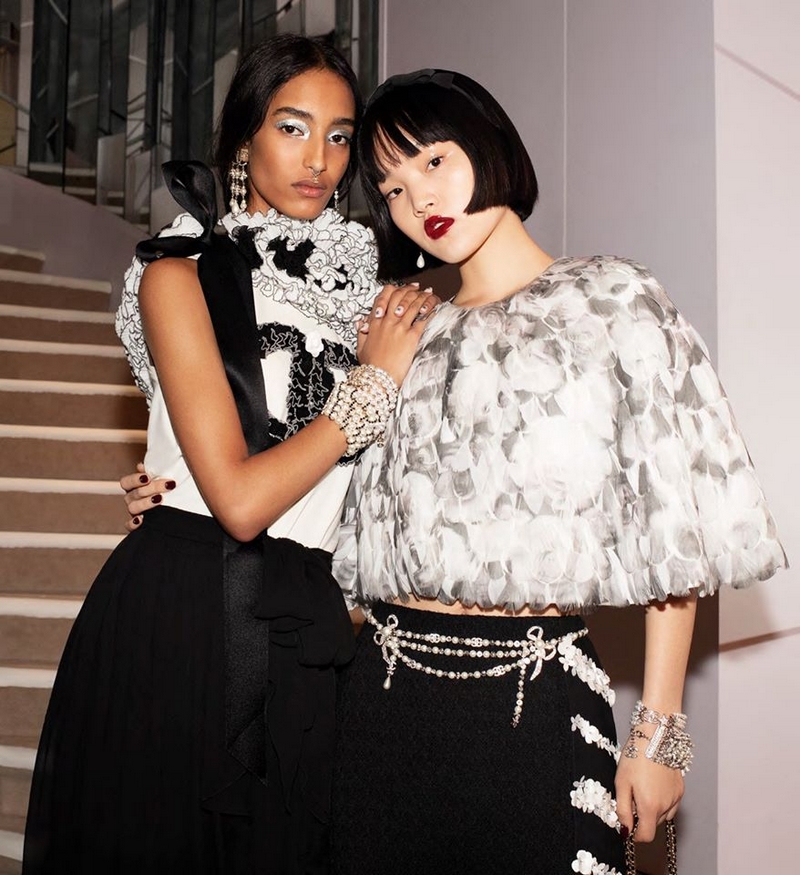
Chanel’s Sautoir necklaces are worn in accumulation on a silk satin dress in the Paris – 31 rue Cambon 2019/20 Chanel Métiers d’art collection, now in boutiques. @Chanel
Pre-pandemic, Chanel’s show would be a highlight of any Paris couture schedule – with a set worthy of a movie. Highlights from previous years have included a replica Eiffel Tower, an abandoned theatre and, last season, a library with books lining the walls.
By contrast, the brand’s contribution to the first digital couture fashion week was a little lower-key. Debuted on Tuesday morning on its website was a one-minute-22-second film with models Rianne van Rompaey and Adut Akech wearing 30 outfits from the house’s most elite collection.
The coronavirus crisis has forced fashion labels to move from physical events to online showcases, as the industry navigates the new normal. This video was showcasing creative director Virginie Viard’s designs to the couture customers who might be tuning in. It contrasted with other brands’ take on going digital, such as Schiaparelli’s film of designer Daniel Roseberry sketching his collection or Christian Dior’s narrative of mythical creatures being coaxed into couture dresses. While the latter film was let down by its lack of diversity in casting, it was probably the most imaginative take on digital couture this week.
The Chanel collection was inspired by the life of the late Karl Lagerfeld, with whom Viard worked for over 30 years at Chanel, before becoming creative director after his death in 2019. In a press release, Viard wrote that she was thinking of “punk princesses”. “Karl would go to ‘Le Palace’,” wrote Viard. “He would accompany these very sophisticated and very dressed-up women, who were very eccentric too.”
If the presentation perhaps lacked the wow factor of the physical shows, the clothes were strong and looked like the serious luxury that the couture client is looking for. Tweed pieces utilised yarn by Vimar, the high-end thread company that Chanel acquired this month. Jewel-like pinks and greens mixed with silver and inky blue – a colour palette that felt chic but also very wearable, should one have the required budget. A series of tiered gowns in taffeta and velvet, and beaded and embroidered pieces, were particularly sumptuous and ready for black-tie events, whenever they might return to social diaries.
Bruno Pavlovsky is Chanel’s excellently titled president of fashion activities and president of the Chanel SAS group. Speaking on video conference, he said a female designer at the helm of Chanel – the most famous fashion house founded by a woman – provided another point of view. “She is a woman designing for women,” he said. “[Customers feel] very comfortable and very happy with this product, which I believe is very important.”
This is the second video Chanel has released since the pandemic. The first, for the “cruise collection”, was released on 8 June. The seven minutes of models standing in front of imagined seascapes and on elegant balconies was criticised as not reading the room while the news cycle focused on the emerging protests around George Floyd’s death and cities emerging from lockdown. It was also seen as a bit of an anticlimax after the razzmatazz of Chanel’s physical shows.
“We feel like it wasn’t enough there [with the cruise show],” conceded Pavlovsky. Arguably, though, Tuesday’s haute couture video takes up where the cruise show left off. The clothes were the focus in both. However, the shorter length and eye-catching makeup and hair, including a mohican, added interest.
Acclaimed art director Fabien Baron, speaking to WWD about the cruise show and fashion film, said a “straight” approach is less engaging. “Let’s remember that film is about image and storytelling, otherwise it can be very flat and an easy medium to lose an audience,” he said.
The figures, however, may suggest otherwise. Pavlovsky said the engagement rate – a measure of how much consumers are interacting with content online – had risen from 7.2% for last year’s physical cruise show to 8.5% for this year’s digital one, perhaps demonstrating that consumers appreciate a straightforward approach to fashion presentations.
Asked about the issue of diversity in fashion, Pavlovsky said it was a priority across Chanel’s business, which was reflected in the diversity of staff in its boutiques across the world. He said this was important for reaching a diverse and international customer base. “Our customers are from everywhere – all cultures, all skin colours … As a brand, I believe we need to continue to be very engaged,” he said. “The best team is a diverse team.”
guardian.co.uk © Guardian News & Media Limited 2010
Published via the Guardian News Feed plugin for WordPress.

